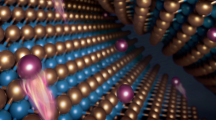Abstract
Of the approaches currently under investigation for the fabrication of functional III–V semiconductor nanostructures, self-organized growth mechanisms and directed growth on patterned substrates have yielded quantum wires and dots with the best structural and electronic properties1. In patterned growth, high densities of structures are difficult to obtain; self-organization, on the other hand, can provide densely packed structures with good crystal quality, but generally offers limited control over nanostructure uniformity and spatial position. In the case of quantum dots, non-uniformity of size and shape is clearly undesirable, as the resulting structures will exhibit a broad range of electronic and optical properties, effectively smearing out the sought-for zero-dimensional behaviour of the dot ensemble. Here we demonstrate a method for improving size uniformity, while maintaining a high density of quantum dots, that combines elements of both self-organization and patterning. The photoluminescence spectrum of the resulting ordered arrays of quantum dots is dominated by a single sharp line, rather than the series of sharp lines that would indicate transitions in quantum dots of different sizes2,3,4,5,6,7.
This is a preview of subscription content, access via your institution
Access options
Subscribe to this journal
Receive 51 print issues and online access
$199.00 per year
only $3.90 per issue
Buy this article
- Purchase on Springer Link
- Instant access to full article PDF
Prices may be subject to local taxes which are calculated during checkout




Similar content being viewed by others
References
Eberl, K., Petroff, P. M. & Demeester, P. (eds) Low Dimensional Structures Prepared by Epitaxial Growth or Regrowth on Patterned Substrates (NATO Advanced Sci. Inst. Ser. E., Vol. 298, Kluwer, Dordrecht, (1995)).
Hess, H. F., Betzig, E., Harris, T. D., Pfeiffer, L. N. & West, K. W. Near-field spectroscopy of the quantum constituents of a luminescent system. Science 264, 1740–1745 (1994).
Brunner, K., Abstreiter, G., Böhm, G., Tränkle, G. & Weimann, G. Sharp-line photoluminescence and two-photon absorption of zero-dimensional biexcitons in a GaAs/AlGaAs structure. Phys. Rev. Lett. 73, 1138–1141 (1994).
Gammon, D., Snow, E. S., Shanbrook, B. V., Kratzer, D. S. & Park, D. Homogeneous linewidths in the optical spectrum of a single gallium arsenide quantum dot. Science 273, 87–90 (1996).
Ramsteiner, M. et al. Influence of composition fluctuations in Al(Ga)As barriers on the exciton localization in thin GaAs quantum wells. Phys. Rev. B 55, 5239–5242 (1997).
Leon, R., Petroff, P. M., Leonard, D. & Fafard, S. Spatially resolved visible luminescence of self-assembled semiconductor quantum dots. Science 267, 1966–1968 (1995).
Marzin, J.-Y., Gerard, J.-M., Izrael, A., Barrier, D. & Bastard, G. Photoluminescence of single InAs quantum dots obtained by self-organized growth on GaAs. Phys. Rev. Lett. 73, 716–719 (1994).
Nötzel, R. et al. Selectivity of growth on patterned GaAs (311)A substrates. Appl. Phys. Lett. 68, 1132–1134 (1996).
Richter, A. et al. Real-space transfer and trapping of carriers into single GaAs quantum wires studied by near-field optical spectroscopy. Phys. Rev. Lett. 79, 2145–2148 (1997).
Nötzel, R., Temmyo, J. & Tammamura, T. Tunability of one-dimensional self-faceting on GaAs (311)A surfaces by metalorganic vapor phase epitaxy. Appl. Phys. Lett. 64, 3557–3559 (1994).
Nötzel, R., Ledentsov, N., Däweritz, L., Hohenstein, M. & Ploog, K. Direct synthesis of corrugated superlattices on non-(100)-oriented surfaces. Phys. Rev. Lett. 67, 3812–3815 (1991).
Okada, Y., Fujita, T. & Kawabe, M. Growth modes in atomic hydrogen assisted molecular beam epitaxy of GaAs. Appl. Phys. Lett. 67, 676–678 (1995).
Okada, Y. & Harris, J. S. J Basic analysis of atomic-scale growth mechanisms for molecular beam epitaxy of GaAs using atomic hydrogen as a surfactant. J. Vac. Sci. Technol. B 14, 1725–1728 (1996).
Miyamoto, Y. & Nonoyama, S. First principles calculation of molecular- and atomic hydrogen reactions on As-terminated GaAs (100) surfaces. Phys. Rev. B 46, 6915–6921 (1992).
Gossmann, H. J., Sinden, F. W. & Feldman, L. C. Evolution of terrace size distributions during thin-film growth by step mediated epitaxy. J. Appl. Phys. 67, 745–752 (1990).
Acknowledgements
We thank E. Wiebicke for preparing the patterned substrates. Part of this work was supported by the Bundesministerium für Bildung, Wissenschaft, Forschung und Technologie.
Author information
Authors and Affiliations
Corresponding author
Rights and permissions
About this article
Cite this article
Nötzel, R., Niu, Z., Ramsteiner, M. et al. Uniform quantum-dot arrays formed by natural self-faceting on patterned substrates. Nature 392, 56–59 (1998). https://doi.org/10.1038/32127
Received:
Accepted:
Issue Date:
DOI: https://doi.org/10.1038/32127
This article is cited by
-
Self-ordered nanostructures on patterned substrates
Journal of Materials Science: Materials in Electronics (2018)
-
Coulomb sink effect on coarsening of metal nanostructures on surfaces
Frontiers of Physics in China (2008)
-
Planar Hall Effect in Epitaxial Fe Layers on GaAs(001) and GaAs(113)A Substrates
Journal of Superconductivity (2006)
Comments
By submitting a comment you agree to abide by our Terms and Community Guidelines. If you find something abusive or that does not comply with our terms or guidelines please flag it as inappropriate.



